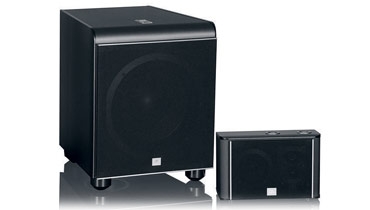JBL ES Series home theater speaker system Page 2

SETUP
Installing the JBLs didn't present any unusual obstacles. I placed the ES80 towers 10 feet apart, about 1 foot out from the front wall, and toed them in to face the listening position. The towers are supplied with threaded spiked feet, but I used the included rubber feet instead. As with any floorstanders, the proximity of the drivers to my tile floor created a reflection that colored the direct sound path. To mitigate this, I placed throw rugs on the floor in front of each cabinet.
The ES25C center speaker went below my TV. Its vertical angle was good, so I didn't adjust its feet. I placed the ES10 surrounds on speaker stands in the back of the room. I wish they had the same adjustable feet as the center speaker so I could have aimed them down a bit.
Subwoofer performance is very dependent on room acoustics and on the sub and listening positions. From experience, I knew to place the ES250P in my room's sub sweet spot, along the front wall and between the TV and the left tower.
MUSIC PERFORMANCE
I started my critical listening with stereo playback, courtesy of KT Tunstall. Her debut album, Eye to the Telescope, was a bona-fide hit and proved that not all new stars need to be Idols. The JBLs reproduced the muscular bass guitar on "Suddenly I See" with good musicality; the subwoofer provided solid fundamental notes while the towers' woofers added the attack of the plucked strings. Likewise, the kick drum, pulled back in this mix, sounded steady and strong. The sat/sub blend was seamless - one of the advantages of using towers for the left and right front channels, instead of small satellite speakers.
Tunstall's lead vocal on the song was clean, as was the touch of reverberation around it. Details were clearly audible, such as nuances in the vocal echoes on the line "I can see her eyes looking from a page in a magazine." That I could hear all of this detail suggests good midrange clarity.
The snare sound was appropriately crisp and snappy, albeit a bit brighter than what I've heard on some other systems. The combination of the normal tweeter and the ultra-high-frequency driver served up lots of presence and air. The entire top end sizzled with energy, and, in fact, it required a little getting used to. But once I got acclimated, I was quite happy with that extreme high-frequency extension.
Expanding my audition to other faves both old and new, I worked through my evaluation checklist. Imaging was accurate, with a good phantom-center image on pop lead vocals, and likewise the panorama of orchestral instruments was continuous across the stereo arc. The soundstage was open and natural, undoubtedly aided by the plentiful high-frequency response.
Turning my attention to music in surround, I listened to the 6-channel mix on the DVD-Audio edition of Led Zeppelin's How the West Was Won. On this album, the center channel is used lightly for lead vocals, but since the ES25C employs the same tweeter module as the towers, the high end sounded well matched. The center speaker's 5-inch woofer falls between the towers' 4- and 6-inchers, but its tonal quality is similar enough. On other surround albums, too, these drivers worked together to reproduce a realistic soundstage across the front, with good image definition.
MOVIE PERFORMANCE
JBL got its start in movie sound, so I wasn't surprised that its ES system handled with aplomb the soundtrack to Hero, a Chinese fantasy spectacle directed by Yimou Zhang. In one scene, the titular character swirls around a blue room, cutting ties holding bundles of sticks. The swooshing sounds of our flying hero, co-mingled with the ringing of his sword, are panned throughout the surround mix. Here, the satellite speakers provided great spatial continuity instead of the blobs of localized sound I sometimes hear on other models.
The subwoofer added to the swirling sound with low-pitched whooshes - an effect that was nicely integrated with the satellites. (A lesser system might have statically localized the low sounds to the sub, degrading the sense of movement.) And when the sticks crashed to the floor in all six speakers, the sense of immersion was complete. Meanwhile, dialogue - hard-panned to the center channel - sounded absolutely clean. As I expected, the center speaker's MTM configuration produced symmetrical horizontal dispersion.
BOTTOM LINE
In a world of tiny satellites - not to mention cute cabinets that are subwoofers in name only - it's comforting to listen to big, traditional speakers from a big, traditional company. JBL has a speaker-design knowledge base that's almost unrivaled. If there's one thing it knows how to do, it's putting drivers in boxes and making them sound damn good.














































